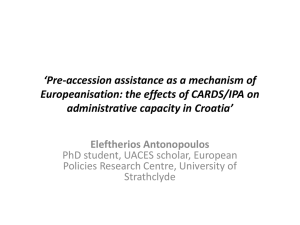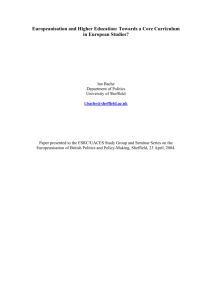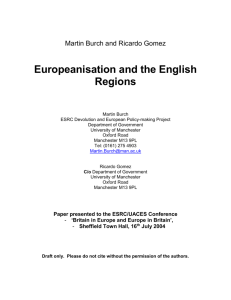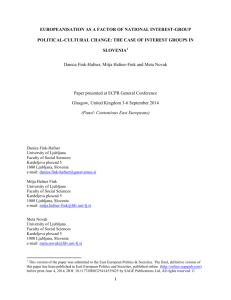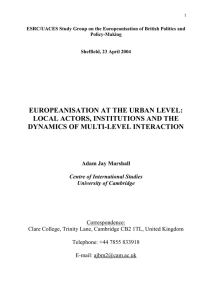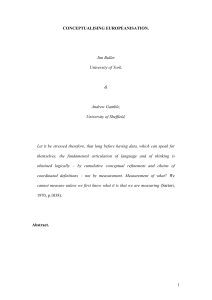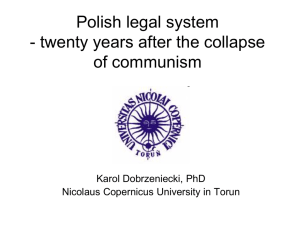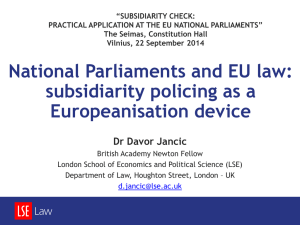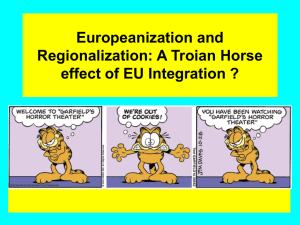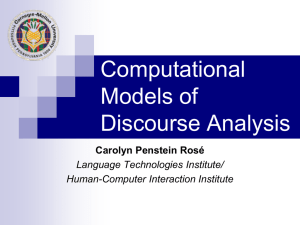Lecture 10
advertisement
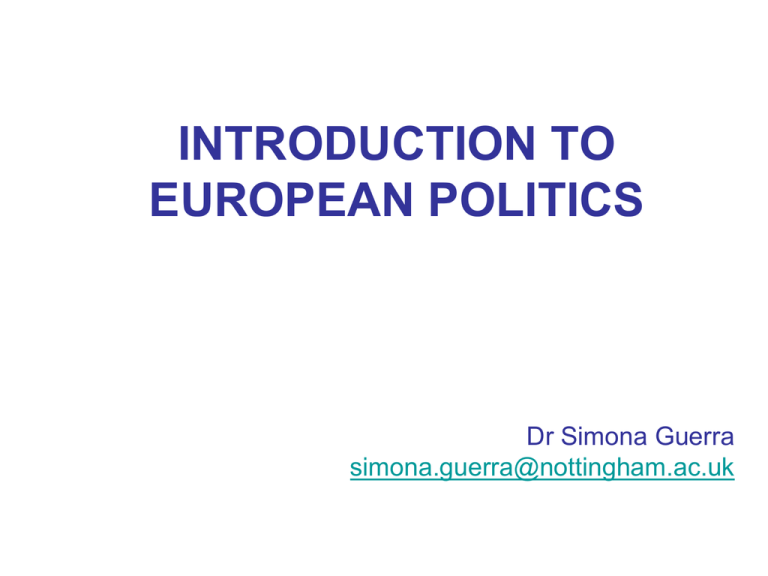
INTRODUCTION TO EUROPEAN POLITICS Dr Simona Guerra simona.guerra@nottingham.ac.uk EUROPEANISATION Definition (key concepts and terms) Europeanisation as process (institutions) Europeanisation as governance Europeanisation as discourse Europeanisation and theories Europeanisation (examples: parties and party systems) A difficult concept: conclusions EUROPEANISATION A DEFINITION ‘Processes of (a) construction, (b) diffusion and (c) institutionalisation of formal and informal rules, procedures, policy paradigms, styles, ‘ways of doing things’ and shared beliefs and norms which are first defined and consolidated in the EU policy process and then incorporated in the logic of domestic discourse, identities, political structures and public policies’ (Radaelli 2003) EUROPEANISATION: WHAT Geographical Europe? – changes in the external borders, EU enlargements Developing institutions at the European level Central penetration of national systems of governance Exporting forms of political organisations (third actors) A political (stronger) unification project (Olsen 2002) Institutionalist approach: Changes in political organisation: organisational/financial capacity for common action and governance Changes in structures of meaning and people’s minds WHY (NEW) INSTITUTIONALISM ‘Institutionalism’s predominance arises because Europeanisation is normally understood as entailing a domestic adjustment process, and member state institutions are typically seen as amongst the intermediating variables in this process’ ‘Europeanisation as a process arising from some kind of ‘misfit’ with the policies and practices of the EU (see Börzel 1999; Risse et al. 2001)’ in Bulmer and Burch 2005 ‘Europeanisation is mostly interested in adaptation to Europe’ (Radaelli 2004) HOW Adaptational pressure (created by misfit between the EU and MSs) and proceeds through two different possible pathways. OR EUROPEANISATION AS GOVERNANCE Does Europeanisation produce good and legitimate governance in Europe? - We studied it last week, is it more successful in CEE (democratic)? Does Europeanisation produce social policymaking capabilities at the domestic level without compensating this with a model of ‘social Europe’ to be delivered by EU institutions (Scharpf 1999, 2001; Mair 2001:47)? Radaelli 2004 OR EUROPEANISATION AS DISCOURSE ‘Policy-makers and stakeholders construct Europe through language and discourse’ ‘Discourse can change the preferences of actors, reformulate policy problems, make a style more confrontational or more cooperative, and can also increase or decrease the value of resources (for example by contesting the legitimacy of corporate actors)’ (Radaelli 2004) EUROPEANISATION & THEORIES Europeanisation and EU integration and theories (intergv’t or supranational/ governance turn) How does the EU interact with its MSs? Negative and positive integration (mutual recognition, Cassis de Dijon case (1979) CASSIS de DIJON CASE Two types of regulatory policies: Negative and positive integration policies (Hix, 2005, pp. 239-260): Negative integration: removal of barriers to international trade and competition. Positive integration: establishment of new EUwide policies (Scharpf, 1996) Cassis de Dijon case law (Case 120/78, 1979; on well-known spirits products, which cannot be sold in the Federal Republic of Germany … the government of the Federal Republic of Germany, …, put forward various arguments which, in its view, justify the application of provisions relating to the minimum alcohol content of alcoholic beverages, adducing considerations relating … the protection of public health and … to the protection of the consumer against unfair commercial practices) (Nicolaidis, 2005), MR sets the conditions governing the recognition of the validity of foreign laws/regulations/standards/certification procedures among states so to assure host country regulatory officials and citizens that the application of such foreign laws within their borders is ‘compatible’ with their own – and incoming products and services are safe EUROPEANISATION: PARTIES AND PARTY SYSTEMS Europe as an issue has not been politicised for a long time Europe limits the degree of freedom of political parties (implementing policies regulatory policies) Europe as a challenge? As a chance? Europe as a channel for Eurosceptic parties? EUROPEANISATION: TIME AND SEQUENCE 1. There is Europeanisation when the logic of domestic political actors changes. When the logic of action and the logic of meaning are guided by Europe. Think of Europe as the ‘grammar’ of domestic political action 2. Europeanisation is change both in the sense of responses to EU pressures and in the sense of other usages of Europe which do not presuppose pressure 3. Europeanisation is a process consisting of complex sequences and time patterns’ (Radaelli 2004) EUROPEANISATION DEPENDing ON POLICIES Irondelle (2003) shows how French military policy has become Europeanised even if EU policies in this area have never taken off First pillar (subject to supra-national policy-making) and Second and third pillar (security and foreign policy CFSP, JHA) (IG) EUROPEANISATION: A DIFFICULT CONCEPT Examples of Europeanisation without major adaptational pressure Domestic actors can use ‘Europe’ even in the absence of pressure They can adapt domestic policy and produce change independently of pressures arising out of institutional misfit LIMITS OF EXPLANATIONS ‘Goodness of fit’ as a too structural approach (?) It can neglect the role of agency, that act only in response to pressure Alternative explanatory approaches: - Instead of separating the domains of policy, politics, and polity (as Börzel and Risse do, 2003), one can investigate the dynamic relations between policy change and macroinstitutional structures (Radaelli 2001) ONLY EUROPEANISATION? We can address the question ‘how does one know that change is correlated or caused by Europeanisation, and not by other variables?’ Other variables, like globalisation and domestic politics, may matter more than Europeanisation (Radaelli 2001) EUROPEANISATION: CONCLUSIONS Removing the confusion of up-loading and down-loading. Europeanisation is both 'pressure' and 'usage‘ Identification of research designs. Only bottom-up research designs can inform on whether change is triggered by pressure or usages Clarifying the distinction between EU policy and Europeanisation. The latter does not presuppose the former Clarifying the role of socialisation processes. Socialisation is neither sufficient, nor necessary condition for Europeanisation REFERENCES Bulmer, S. and Burch, M. (2005) ‘The Europeanization of UK Government: From Quiet Revolution to Explicit Step-Change?, Public Administration, Vol. 83, No. 4, pp. 861-890. Featherstone, Kevin and Claudio Radaelli (eds) (2003). The Politics of Europeanization. Oxford: OUP. [e-book] (especially Chapter 1 and Chapter 3). Hix, S. (2005), The Political System of the European Union, Basingstoke: Palgrave Macmillan, 2nd ed. Nicolaidis, K. (2005), ‘A World of Difference: Exploring the Dilemma of Mutual Recognition’, Paper presented at Princeton, 17-19 February, draft version. Olsen, J. P. (2002) ‘The Many Faces of Europeanization’, Journal of Common Market Studies, Vol. 40, No. 5, pp. 921-952. Quaglia, L. et al. (2007) ‘Europeanization’ in M. Cini (ed) European Union Politics, Oxford: Oxford University Press, 2nd ed., pp.405-420. Radaelli, C. (2004) ‘Europeanization: Solution or Problem? European integration online papers, Vol 8 available at http://eiop.or.at/eiop/texte/2004-016a.htm

